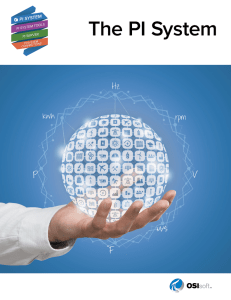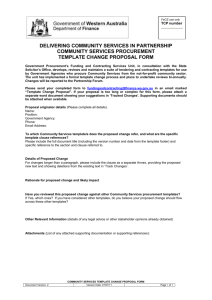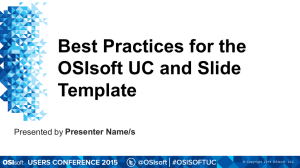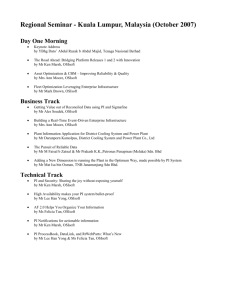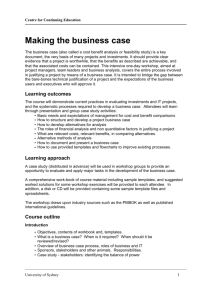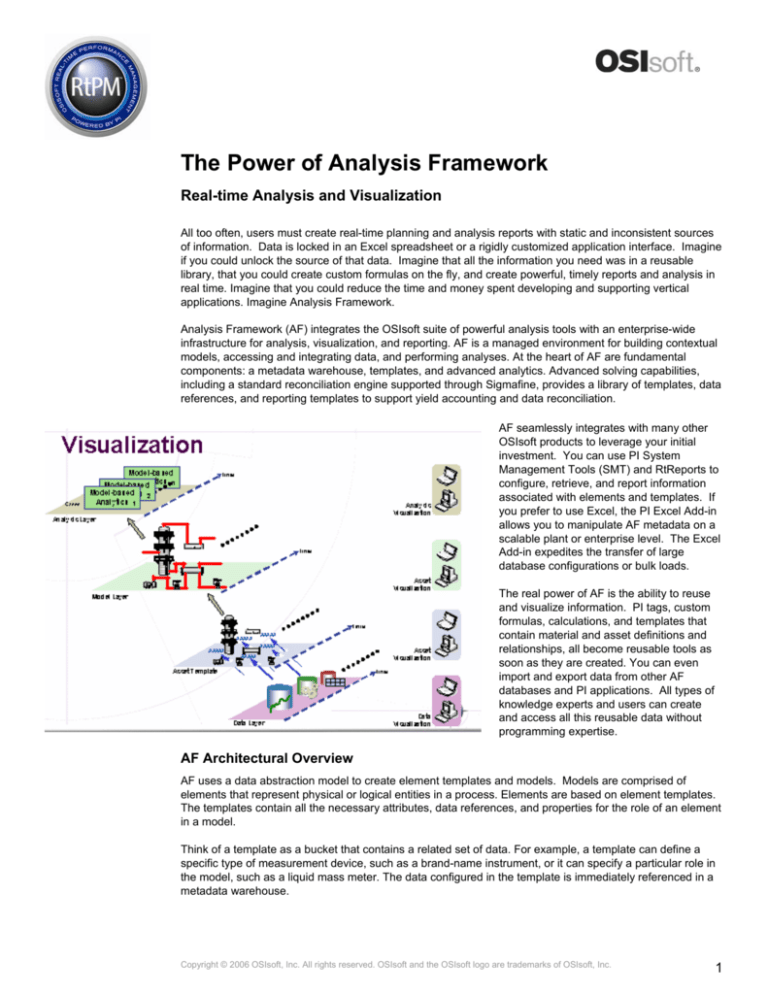
The Power of Analysis Framework
Real-time Analysis and Visualization
All too often, users must create real-time planning and analysis reports with static and inconsistent sources
of information. Data is locked in an Excel spreadsheet or a rigidly customized application interface. Imagine
if you could unlock the source of that data. Imagine that all the information you need was in a reusable
library, that you could create custom formulas on the fly, and create powerful, timely reports and analysis in
real time. Imagine that you could reduce the time and money spent developing and supporting vertical
applications. Imagine Analysis Framework.
Analysis Framework (AF) integrates the OSIsoft suite of powerful analysis tools with an enterprise-wide
infrastructure for analysis, visualization, and reporting. AF is a managed environment for building contextual
models, accessing and integrating data, and performing analyses. At the heart of AF are fundamental
components: a metadata warehouse, templates, and advanced analytics. Advanced solving capabilities,
including a standard reconciliation engine supported through Sigmafine, provides a library of templates, data
references, and reporting templates to support yield accounting and data reconciliation.
AF seamlessly integrates with many other
OSIsoft products to leverage your initial
investment. You can use PI System
Management Tools (SMT) and RtReports to
configure, retrieve, and report information
associated with elements and templates. If
you prefer to use Excel, the PI Excel Add-in
allows you to manipulate AF metadata on a
scalable plant or enterprise level. The Excel
Add-in expedites the transfer of large
database configurations or bulk loads.
The real power of AF is the ability to reuse
and visualize information. PI tags, custom
formulas, calculations, and templates that
contain material and asset definitions and
relationships, all become reusable tools as
soon as they are created. You can even
import and export data from other AF
databases and PI applications. All types of
knowledge experts and users can create
and access all this reusable data without
programming expertise.
AF Architectural Overview
AF uses a data abstraction model to create element templates and models. Models are comprised of
elements that represent physical or logical entities in a process. Elements are based on element templates.
The templates contain all the necessary attributes, data references, and properties for the role of an element
in a model.
Think of a template as a bucket that contains a related set of data. For example, a template can define a
specific type of measurement device, such as a brand-name instrument, or it can specify a particular role in
the model, such as a liquid mass meter. The data configured in the template is immediately referenced in a
metadata warehouse.
Copyright © 2006 OSIsoft, Inc. All rights reserved. OSIsoft and the OSIsoft logo are trademarks of OSIsoft, Inc.
1
The Power of Analysis Framework
Real-time Analysis and Visualization
The AF Metadata Warehouse – A Smart Repository
The AF metadata warehouse (AF Database) is the smart repository that defines all AF assets, physical or
logical, from the simplest attribute to the most complex template library. Each PI System contains one
default metadata warehouse. One PI Server stores the AF metadata warehouse in a designated instance of
the Model Framework Subsystem; although you can retrieve the associated process data from PI Points
from any number of PI Servers. Most functionality that the modeling framework provides is contained in the
AF database object.
A metadata warehouse complements your relational database. While a relational database stores data, a
metadata warehouse describes the data and points to its location. In this way, it has embedded relational
intelligence. The metadata warehouse can import references from outside sources and provides
mechanisms for loading relational tables and other data types. Once a user saves data attributes to a
template, the data becomes transformed to metadata and becomes a part of the template wherever it is
placed. This transformation from data to metadata enables users to reuse the information in a template.
The same metadata is available throughout the enterprise. You can apply it to any context, such as solving
financial issues, organizing facilities management, and analyzing problems. For example, you can create
views of complex real time operations or solve complex “What if” modeling scenarios. Metadata is especially
useful for dynamic calculations, where it can speed time range calculations or other applications with
intermediate values that do not need to be stored. Metadata becomes part of an every-growing library of
information that the enterprise can reuse to solve new problems.
The AF Template – Configuring Smart Objects
Once, a picture of a tank was a just a picture. However, if you base a template on an asset, tank_template,
you can associate data with the asset. If you add another asset-based template and call it tank2_template,
you can connect and group assets. Now, drop the tank_template and tank2_template element from AF into
ProcessBook for dramatic visualization and analysis. The copied assets contain all the attributes and data
references you gave it. The tank has become a smart object.
A template associates data with assets. It defines specific instances or attributes of an object, such as a tank
or a stream. The attributes range from simple string values to sophisticated data references, including PI
tags, Table Lookups, and Formulas. The AF
allows you to configure, rather than program
data references and formulas. The extensive
group of formula and unit of measurement
(UOM) pull-down menus and libraries allow any
knowledgeable user to set sophisticated
calculations and formulas.
Once you create multiple templates, you can
nest templates or create template libraries to
reflect the complexity of your operation or
enterprise. Through the creation of different
templates and different attributes, you can easily
create new views and models of your plant and
assets. You can even import and export the
templates to other AF metadata warehouses. AF
relies on xml as its base format for importing and
exporting databases, templates, and
calculations. The xml format expedites import to
and export from other data types.
Copyright © 2006 OSIsoft, Inc. All rights reserved. OSIsoft and the OSIsoft logo are trademarks of OSIsoft, Inc.
2
The Power of Analysis Framework
Real-time Analysis and Visualization
Meaningful Organization of Data
The AF helps you to organize of all of your data—1000s of points—in a meaningful way. The templates help
you to logically structure data and apply context to the data through models, elements, and objects. You can
create unified asset and connectivity-based models to organize, name, and map assets in user-friendly,
searchable terms. For example, you can name data objects by a naming convention—the way you might
use the data in analysis—by category, or by type. With a central source to organize your data, assets and
models become the basis for consistent and faster visualization and analyses.
For example, you could show different views based on:
•
The relevant assets of an operation (tanks, meter, reactors)
•
The relationships needed to support advanced calculations, such as yield accounting and data
reconciliation
The following diagrams show you three ways that you might group the same template assets by reusing the
template:
•
The hierarchical relationship groups
•
The flow relationship connects
•
The role relationship by function
Putting AF to Work for You
AF tools target solutions throughout the enterprise from the developer group to the CEO – all can benefit
from the power of AF. While the standard AF features achieve remarkable results, the real power of AF is
as an application development framework. Both third-party vendors and customers are developing custom
applications that use the resources within AF and maintain the same ease of use. OSI customers are
embracing these applications today – to replace legacy applications and to expedite inventory, planning,
finance calculations, and analysis. This section describes several of these applications, including:
•
Tank Calculation Services
•
Movement Management
•
KPI Management Framework
•
Refinery Yields Management
Copyright © 2006 OSIsoft, Inc. All rights reserved. OSIsoft and the OSIsoft logo are trademarks of OSIsoft, Inc.
3
The Power of Analysis Framework
Real-time Analysis and Visualization
Tank Calculation Services
The Tank Calculation services provide volume and weight calculations for both operations and finance
groups. Tank Calculation Services apply wherever tanks represent major assets – especially within the
energy, petrochemicals, and chemical industries.
The beauty of the Tank Calculation Services is that the same infrastructure can support concurrent online
and on demand calculation scenarios. The online calculation engine can run periodically or by event. All
calculated volumes and weight attributes write back to PI tags. The on-demand scenario is supported by an
SOA implementation through web services, which exposes tank calculation services across the enterprise.
Tank configurations are stored in one place for the entire company – the PI-AF database.
Several OSIsoft customers recently replaced legacy applications with Tank Calculation Services. Open data
access has revolutionized the business at all levels. The CEO appreciates that his managers can derive all
calculations in a consistent way. Inventory managers routinely reuse tank calculations templates as they
update daily and weekly reports and projects. Planners can now project more accurate futures.
Movement Management
The Movement Management application monitors and tracks material movements for all corporate-wide
operations. Movement Tracking applications and engines apply wherever managing the movement of
operations is critical to the company, especially in energy, petrochemicals, and chemical industries.
Movement Management far exceeds the
quality of tank and movement data for
inventory and accounting legacy applications.
Movement Manager tracks all movement data
in a single graphical view – a view that
leverages your OSIsoft preferences. A facilities
manager can view and edit the transfers and
associated attributes in the AFExplorer, in
ProcessBook, in Excel, and in DataLink.
Adding Transfers to the Analysis Framework
Movement Manager is a flexible, time-saving
tool that managers can combine with other AF
applications to expedite asset tracking and
movement. It identifies operations
inconsistency by cross-checking tank and
movement data. Movement Management also
solves complex scenarios to calculate
movement quantity.
KPI Management Framework
The KPI Management Framework leverages the AF Framework and RtPortal infrastructures to provide a
complete environment to define, aggregate, distribute, and visualize Key Performance Indicators (KPI). The
framework allows users to select any information managed by OSIsoft infrastructure, such as PI tags or AF
attributes and formulas to be a key performance indicator. Managers can assign specific attributes to define
KPI behaviour at calculation and presentation time, such as efficiency, maintenance, possible states and
limits, weight factors, and rollup rules.
Copyright © 2006 OSIsoft, Inc. All rights reserved. OSIsoft and the OSIsoft logo are trademarks of OSIsoft, Inc.
4
The Power of Analysis Framework
Real-time Analysis and Visualization
AF data reference allows users to select any
attribute of AF databases as KPI
The KPI Framework allows free definition of KPIs
starting from existing or derived information. It
detects KPIs and organizes them into hierarchical
views. It also automatically generates aggregated
indicators to support overview and drill-down
analysis. The KPI Framework publishing features
provide translation of KPI models to structures that
can be viewed in RtWebParts in Microsoft Share
Point and ProcessBook.
Refinery Yields Management
The Refinery Yields Management environment expedites refinery yields reconciliation, aggregation,
analysis, and presentation. An AF analysis data reconciliation module calculates yields and yield
calculations. With AF, users can aggregate the calculations to show per shift and per types of processed
crude and to provide valuable history for future analysis. Performance indicators measure the overall
performance of the refinery and provide an indication of the deviation between actual and theoretical yields.
Yield reconciliation model
A recent OSIsoft customer
implemented the complete
yield scenario from planning
to reconciling and
aggregation. The company
boasts impressive economic
savings from increased yield
profitability and reduced
crude switching time.
•
The Operations Manager
runs yields automatically
on an hourly basis to
view online performance
indications for the entire
refinery. Online
performance monitoring
allows to rapidly identify
yield degradation due to
incorrect operating
parameters
•
Historical analysis allows the Production Manager to redefine better targets starting from the improved
performance of the refinery
•
The Facilities Manager now enjoys a high degree of control over crude switching operations
Copyright © 2006 OSIsoft, Inc. All rights reserved. OSIsoft and the OSIsoft logo are trademarks of OSIsoft, Inc.
5
The Power of Analysis Framework
Real-time Analysis and Visualization
Return on Investment
AF provides a return on investment in both real cost savings and in facilitating a more productive work
environment.
Better Understanding, Communication, and Collaboration
Since AF stores knowledge in a central repository, the metadata warehouse, in a logical way that the entire
enterprise can easily access. Any employee, who requires access, can share in the company’s knowledge
base, thus empowering each worker to perform new types of analysis, to communicate, and to collaborate.
For example, without AF, only a planner might have access to the facilities asset data. Now, those who
have access to the assets, the facilities managers and site coordinators can use the same asset and model
reference to visualize and analyze solutions. Working together, they can provide more timely information
and create more accurate asset plans.
Cost Savings
Sites that are using AF have experienced an incremental return on investment throughout the enterprise:
•
Cost savings in time and resources due ability to organize data meaningfully and repurpose work, such
as the modeling and consistent naming conventions of company assets, application and calculation
development, and timely data sharing between departments
•
Reduced error and inconsistency due to human input or dispersed calculations due to the reusability
metadata
•
More streamlined decision making by replacing programming with configuration: employees closest to
the information can configure formulas and data references, while programmers returned to system and
application development
•
Efficient and cost effective way to maintain information due to a central source of data
•
Investment in displays, reports, and business logic protected
•
Reduces product development lifecycle
Copyright © 2006 OSIsoft, Inc. All rights reserved. OSIsoft and the OSIsoft logo are trademarks of OSIsoft, Inc.
6

